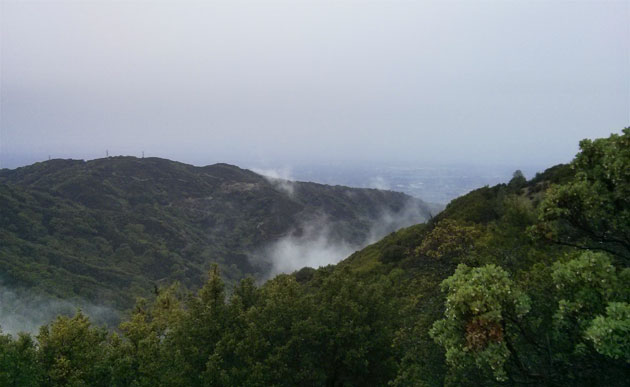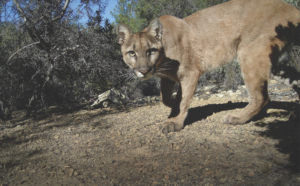he road to the summit of Mount Umunhum meanders through chaparral, bay-oak woodland, and manzanitas that glow rusty red in the rain. Morning mist rises like smoke from the deep green valleys that curve into view, and higher up, the vegetation becomes sparser, with conifers and moss-covered rocks dotting the landscape. The convoy of cars winding up the mountain turn a corner and the 80-foot tall concrete monolith that marks the summit emerges from the fog.
Meredith Manning, a project manager with the Midpeninsula Regional Open Space District who has watched over the rebirth of the summit, steps from her car into a bracing wind. Midpen staffers and volunteers crowd in behind her. “Welcome to Mt. Umunhum!” Manning says.
ven in the chill, excitement permeates the air; one day this summit will be open to the public, but for now, it’s a rare event to see what the Ohlone called the “resting place of the hummingbirds.” Rising 3,486 feet above San Jose, the fourth-largest peak in the Santa Cruz Mountains has been closed off for decades, first as a Cold War-era military station, more recently as Midpen works to clean up the site.
Last Friday, that cleanup reached a symbolic point. After years of demolition and cleanup, a handful of volunteers and Midpen staff visited the summit to install nesting boxes for rare purple martins that call the summit home. Preparing the summit for the martins marks a special moment in the restoration process — of the completion of the demolition phase and a celebration of the summit’s rebirth as a habitat and natural wonder.
“This was my legacy, my life for a long time,” Manning said of the arduous process of preparing the summit for a return to nature. It took 25 years and a lot of wrangling to find the money to demolish buildings and clean up the summit — but once they did, “man, we went for it,” she said.

Now only one old building remains — and will likely remain — the 80-foot tall long-range radar tower affectionately known as “the cube” to residents of the Santa Clara Valley.
With the buildings out of the way, Midpen has been able to focus on restoring more natural conditions to the summit, a process made urgent by the discovery in 2011 of a population of breeding purple martins. When the district bought the land in 1986, it didn’t know the purple martins were there – in fact, it seems, almost no one did.
“Because this area has been closed nobody was around to say, ‘Hey, that’s a martin,'” said Alvaro Jaramillo, a contract ornithologist for Midpen.
he purple martin, the largest member of the swallow family, is a cheerful harbinger of spring in North America. Like their relatives, the famous swallows of San Juan Capistrano, they return from wintering grounds in South America to the same nests every year.
But introduced species such as European starlings often compete with them for the natural cavities where they make their nests. “They like big, old, dead conifers,” Jaramillo said. The situation is so bad in the East that the birds are completely dependent on manmade martin houses for their survival.
And now Mount Umunhum has become their place of rest in Santa Clara County – the only place in the area where they are known to breed. “They probably used to be all over,” Jaramillo said, “but when starlings came in they retreated to oddball areas, like freeway underpasses, or up high on mountaintops.”
On Mount Umunhum’s summit the martins found just what they needed. “There’s insects, there’s habitat, enough to keep them around when no one was looking,” Jaramillo said.
They even found ideal nesting sites in holes created by northern flickers in old telephone posts. Many of these weathered poles couldn’t be salvaged in the demolition process, so the Midpen team is now working to replace them by the time the martins return in April.
In order to appease the notoriously picky bird’s preference for open, high nest sites, the team is installing nest boxes on the top of 13-foot-tall metal posts, two nest boxes to each post, which will be angled out of the wind and intense summer sun. The posts they are using are heavy – 84 pounds each – and will be set deep in the ground. It took several volunteers to lift one into place, and as the first one went up in a classic raising-the-flag scramble, cheers and laughter rang out across the summit.

“These boxes are not the kind you buy in your yard to look nice,” Jaramillo said. And while it’s true that the rectangular, plain-wood boxes don’t exactly look like something out of Extreme Makeover: Birdhouse edition, they have been designed to maximize martin well-being, with side-perches and ventilation holes as well as a fancy door for cleaning.
The entrance allows martins to go in and out but excludes starlings, who are too squat to fit through. It’s all a bit of an experiment, but Jaramillo said he’s optimistic, and he hopes that the birds will also continue to nest in natural cavities around the summit.
art of the excitement of opening the mountain, even on a limited basis to Midpen staff and volunteers, is that the mountains’ biodiversity is only now being discovered. Jaramillo said he’s not surprised it’s turning out to be so rich: There is a complex mosaic of vegetation that varies with elevation and the angle of the hills to the ocean or inland valleys.
“That’s what makes the mountain so interesting, that diversity,” he said.
As for the mountain’s namesake bird, Anna’s hummingbirds can be seen year-round, while Allen’s and rufous are more likely to be found in the spring and summer. And then there are the animals at the top of the food pyramid: Jaramillo said that on almost every trip to the summit he has seen a golden eagle, and a coworker once saw a puma standing in an almost too-majestic pose atop a serpentine outcropping overlooking the valley below.
he air at the summit is permeated with the smell of woodchips, crushed-up remnants of old wood-framed military housing that has been repurposed as ground cover. For now, the woodchips cover the bald spots where buildings once stood.
“I was actually hoping it would snow today,” said Amanda Kim, the communications supervisor for Midpen. “I like seeing the summit in the snow because you can imagine what it will look like without the scars.”
While Midpen staff plan to replant certain areas with native seed, the team is confident that nature will find its way back in time.
The district hopes to allow access to the summit for scenic viewing, birding, and recreation by 2017, via a 1.7-mile trail or special vehicle permit. But another $3 million is needed to repair the road and allow general access to the summit, as well as hundreds of thousands of dollars to repair the cube so that it is safe for the public. From start to finish the project is expected to cost $13 million.
Once finished the mountain will have an ADA accessible summit trail, a shade pavilion, a Native American ceremony ground, and one of the most unique views in the Bay Area, allowing it its rightful place alongside Mount Tamalpais and Mount Diablo. On a clear day visitors will be able to see all the way from Monterey Bay to Mount Tam and even to the Sierra. And in warmer months, they will be able to see the shimmery sheen of a purple martin as the adept aerial acrobats dive about catching insects on the wing.
“Think of all the people who will learn about this species,” Manning said. “They will come to look at the view and say, ‘Oh wow, what is that?’'”
It wasn’t the best weather on the mountain Friday, but Lynn Jackson, who’s been volunteering for the district since 2006, said it was well worth the hardship. “Putting something up for the purple martins is amazing,” she said. “Look at all the people up here doing all this! It’s a really special place.”


